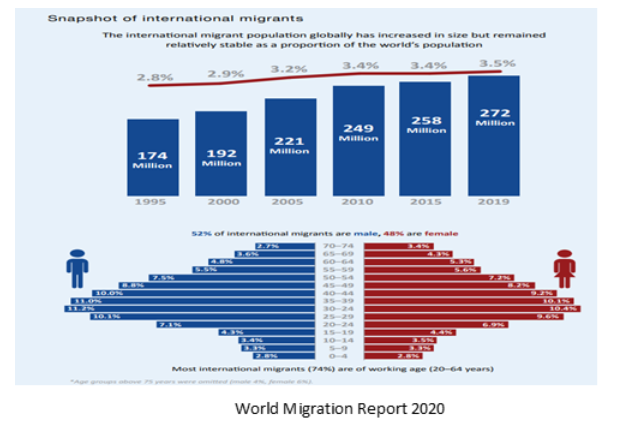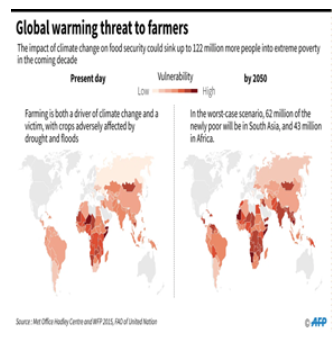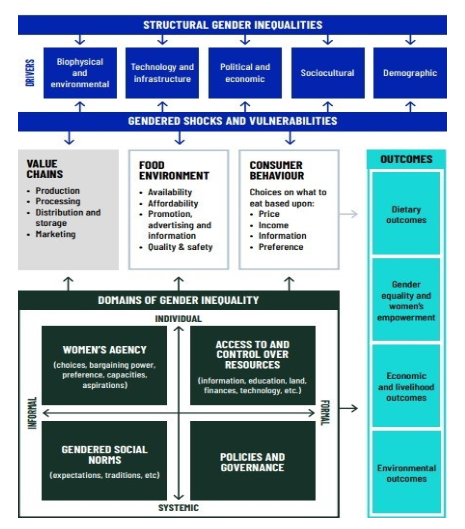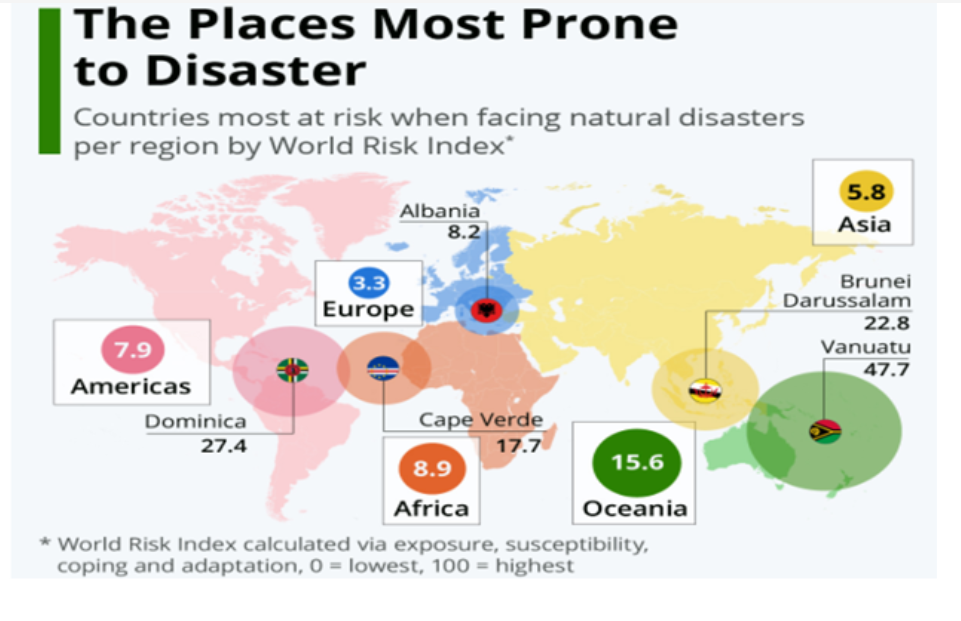10 Jan to 24 Jan, 2024
ADDRESSING PLASTIC POLLUTION
Why in news : By 2050, emissions generated from the plastic life cyle could exceed 56 gigatons, or up to 10%–13% of the remaining carbon limit set by the Paris Agreement.
About :
The plastic pollution crisis is a global environmental issue characterized by the excessive accumulation of plastic waste in natural habitats, particularly oceans. This pollution stems from inadequate recycling, single-use plastics, and poor waste management. It poses significant threats to wildlife, ecosystems, and potentially human health, as microplastics infiltrate food chains.
Sources of Plastic Pollution
- Single-Use Plastics: These include items like plastic bags, straws, coffee stirrers, soda and water bottles, and most food packaging. According to the United Nations Environment Programme (UNEP), globally, we produce about 300 million tons of plastic waste every year, nearly equivalent to the weight of the entire human population.
- Packaging Industry: As per a report by the Ellen MacArthur Foundation, packaging accounts for over 40% of total plastic usage. The convenience of plastic packaging for storage and transportation continues to drive its demand, exacerbating pollution.
- Microplastics in Cosmetics and Personal Care Products: Microbeads, tiny plastic particles found in some cosmetics and personal care products, are a significant source of marine plastic pollution. A single shower can result in 100,000 plastic particles entering the ocean, as reported by the International Union for Conservation of Nature (IUCN).
- Fishing Industry: Fishing gear, such as nets, lines, and ropes, often made of plastic, contributes to oceanic plastic pollution. The United Nations Food and Agriculture Organization (FAO) estimates that about 640,000 tonnes of fishing gear are left in the oceans every year, posing threats to marine life through 'ghost fishing'.
- Industrial Processes: Plastic pellets, also known as nurdles, used in the production of plastic products, are another source of pollution. Accidental spillage during transportation and handling can lead to these pellets entering water bodies. A study by Eunomia Research & Consulting suggests that up to 53 billion nurdles may be spilled in the UK alone each year.
- Consumer Lifestyle: The increasing consumerism and throw-away culture in many societies contribute significantly to plastic waste. A lifestyle that prioritizes convenience and low cost over sustainability has led to increased plastic use and disposal.
Plastic waste and its Impact
- Economic Impact: The cost of cleaning up plastic pollution burdens governments and communities. The Asia-Pacific Economic Cooperation (APEC) estimated that the economic impact of oceanic plastic pollution on tourism, fishing, and shipping industries was approximately $1.3 billion in the Asia-Pacific region.
- Agricultural Impact: Plastic mulch used in agriculture can degrade into microplastics, affecting soil health and crop quality. Studies have shown that these microplastics can affect soil fertility and water retention.
- Climate Change: Production and decomposition of plastics contribute to greenhouse gas emissions, exacerbating climate change. For example, the production of plastics generated about 400 million tons of CO2 in 2015.
- Marine Ecosystems and Wildlife: Plastics in oceans harm marine life through ingestion, entanglement, and habitat disruption. Over 1 million seabirds and 100,000 marine mammals are killed annually due to plastic pollution, as reported by the U.S. National Oceanic and Atmospheric Administration (NOAA).
- Food Web Contamination: Microplastics are ingested by marine organisms, entering the food web and potentially affecting human health. A study published in Down To Earth found that 90% of sampled table salt contained microplastics.
- Disaster-Related Impacts: After natural disasters, the accumulation of plastic waste can obstruct drainage systems, exacerbate flooding, and hinder relief efforts. Post-Tsunami scenarios in Southeast Asia have demonstrated such effects.
- Forest Ecosystems: Discarded plastics in forests affect soil quality and wildlife. Plastic waste can leach toxins into the soil and physically disrupt root systems, impacting forest health.
|
CASE STUDY : GREAT PACIFIC GARBAGE IN PACIFIC OCEAN ( GPBP) The GPGP covers an estimated surface area of 1.6 million square kilometers, an area twice the size of Texas or three times the size of France. The patch contains at least 79,000 tons of ocean plastic, constituting approximately 1.8 trillion pieces. The bulk of this debris, about 92%, consists of larger objects, while 8% of the mass is microplastics (pieces smaller than 5mm in size). The plastics and microplastics in the patch pose significant threats through ingestion and entanglement. Cleaning up the GPGP is a daunting task, primarily due to its immense size and the continuous accumulation of debris. |
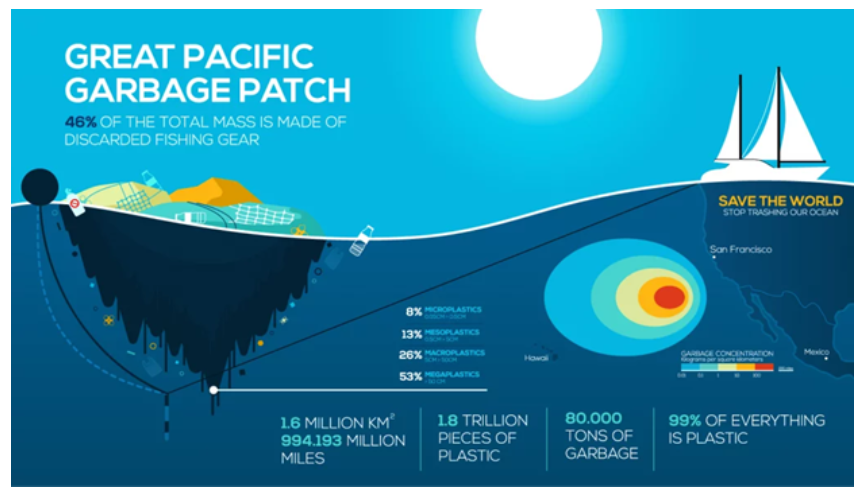
Challenges of Plastic Waste
- Microplastic Pollution: These tiny particles enter the environment through inland waterways, wastewater outflows, and are also transported by wind and ocean tides. An example of this is the contamination of the Great Pacific Garbage Patch.
- Proliferation of Non-Verified Biodegradable Plastics: In the absence of stringent testing and certification processes, many of these products are spurious, failing to meet their environmental claims. This exacerbates the plastic waste problem as consumers and businesses are misled about the environmental impact of these materials.
- Impact of Online Retail and E-Commerce: The growth of online retail and food delivery services, often rely heavily on plastic packaging, contributing to the overall plastic footprint. Study in India showed that online food delivery services generated approximately 22,000 tonnes of plastic waste in 2020 alone.
- Challenges in Implementation and Monitoring of Regulations: Despite the introduction of the Plastic Waste Management (PWM) Rules in 2016 and subsequent amendments in 2018, there has been a failure in effective implementation and monitoring, particularly by local bodies and municipal corporations. Central Pollution Control Board report in 2021 highlighted that only a fraction of Indian cities had implemented effective plastic waste management systems as per the PWM Rules.
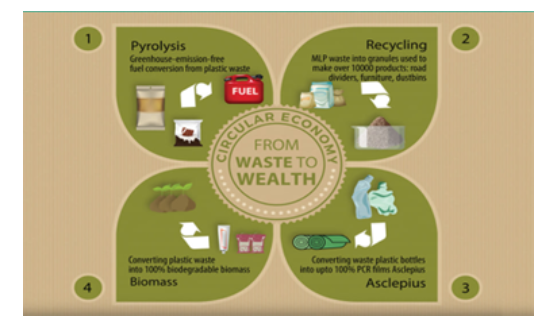
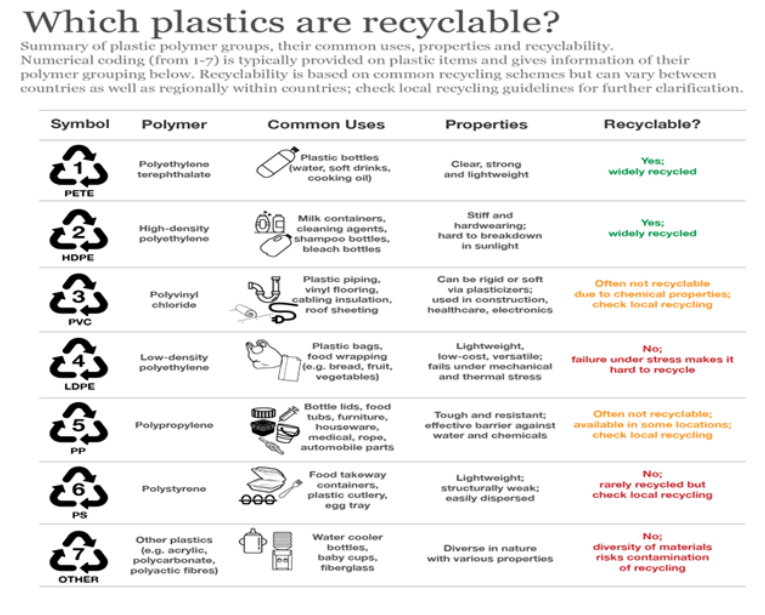
Global Efforts To Tackle it
- London Convention : The 1972 Convention on the Prevention of Marine Pollution by Dumping Wastes and Other Matter
- MARPOL : The 1978 Protocol to the International Convention for the Prevention of Pollution from Ships (MARPOL)
- GloLitter Partnerships (GLP): It is a project launched by the International Maritime Organization (IMO) and the Food and Agriculture Organization of the United Nations (FAO) and initial funding from the Government of Norway.
- Clean Seas Campaign: It aimed to mobilize a worldwide effort to curb plastic pollution by minimizing the use of non-essential and problematic plastics, particularly single-use varieties, and by gradually eliminating the intentional addition of microplastics.
- Greenpeace: This NGO focuses on ocean and marine life conservation worldwide. Its grassroots campaigns have led to bans on harmful fishing methods, shifts in corporate fishing policies, and the establishment of whale sanctuaries.
India’s Efforts In Tackling Plastic Waste
- Ban on Single-Use Plastics: Many Indian states have prohibited the production, usage, and sale of single-use plastic items like bags, cups, and straws.
- Extended Producer Responsibility (EPR): Under EPR, plastic manufacturers in India are held accountable for the disposal and management of waste from their products.
- Plastic Waste Management Rules: The 2016 Rules provide guidelines for managing plastic waste, emphasizing recycling and waste-to-energy methods.
- Plastic Waste Management (Amendment) Rules, 2022: These include EPR guidelines and a ban on specific single-use plastic items, as well as plastic carry bags thinner than seventy-five micrometers.
- Swachh Bharat Abhiyan: This national cleanliness campaign involves plastic waste collection and disposal initiatives.
- Plastic Parks: India has established specialized zones for the recycling and processing of plastic waste.
- Beach Clean-Up Drives: Government and NGOs in India regularly organize beach clean-ups to remove plastic waste.
- International Commitment: India is a signatory to the MARPOL convention, aimed at preventing marine pollution.
- India Plastic Challenge – Hackathon 2021: A competition encouraging startups, entrepreneurs, and students to develop solutions for plastic pollution and single-use plastic alternatives.
Way Ahead/Suggestions
- Adopt a Zero-Waste Lifestyle: Embrace sustainable products like reusable mugs, water bottles, and food wraps. Opt for eco-friendly personal items such as menstrual cups, bamboo toothbrushes, and shampoo bars.
- Sustainable Travel: Minimize single-use plastic usage during travel. Avoid hotel mini-bottles, bring reusable water bottles, and use microplastic-free sunscreen.
- Eco-Friendly Fashion: Considering the fashion industry's significant environmental impact, choose sustainable clothing brands, shop vintage, and repair clothing instead of discarding it.
- Plastic-Free Personal Care: Select personal care products without plastic, as these directly contribute to ocean microplastic pollution.
Government and Community Efforts
- Innovative Product Design: Focus on replacing plastic items with non-plastic, recyclable, or biodegradable alternatives. Collaborate with designers for sustainable product development.
- Technologies and Innovation: Develop tools for governments and organizations to monitor and manage plastic waste effectively.
- Municipal and Community Actions: Engage in beach and river clean-ups, run public awareness campaigns, and implement disposable plastic bag restrictions.
- Multi-Stakeholder Collaboration: Foster cooperation among government bodies, industries, NGOs, and volunteer groups for policy development, implementation, and oversight.
Where to use :
Paper I ( Geography optional ) : Environmental Geography
Paper III ( General Studies ) : Waste Management , Environment Pollution & Degradation
CLIMATE CHANGE CAUSING MORE FREQUENT , INTENSE CYCLONES ON INDIA’S WESTERN COAST
Why in news : Studies revealed that Human-induced climate change is causing more frequent and intense cyclones on India's west coast.
About :
- Recently, a study has been published in the Nature Journal, which highlights the concerns related to Climate Change causing frequent Tropical Cyclones (TC) in the Eastern Arabian Sea.
- The study is part of the "Forecasting with Fisher's" project, by the Advanced Centre for Atmospheric Radar Research (ACARR) at Cochin University of Science and Technology (CUSAT).
Key Findings of the Study :
- Shifts in Cyclone Patterns: The Arabian Sea has historically seen tropical cyclones primarily during the early and late phases of the southwestern monsoon season (March-June and October-December). Notably, in 2019, this region witnessed an unprecedented increase to five cyclones, surpassing the typical average of three. This change coincided with a positive phase of the Indian Ocean dipole (IOD).
- Role of Indian Ocean Dipole (IOD): The IOD, which functions similarly to El Nino, is characterized by differential heating of ocean parts. In its positive phase, the sea surface temperatures rise in the western part of the Indian Ocean, which correlates with increased precipitation and rainfall in the eastern Indian Ocean area.
- Influence of Anthropogenic Climate Change: The recent surge in the occurrence of extremely severe cyclonic storms in this region is predominantly attributed to anthropogenic climate change. This pattern deviates from natural fluctuations, suggesting that climate change is not only intensifying but also contributing to the increased frequency of cyclones.
- Consequences for Western India: The escalation in cyclone intensity poses significant threats to the western coast of India, stretching from Gujarat to Thiruvananthapuram. This includes heightened risks of potent winds, storm surges, and intense rainfall.
- Risks for Coastal Communities: The increased cyclonic activity poses a substantial risk to human lives and economic stability. Coastal communities are particularly vulnerable, facing threats from potent winds, torrential rains, and storm surges. These conditions often lead to casualties and substantial destruction to agriculture, livestock, and fisheries, causing considerable economic setbacks.
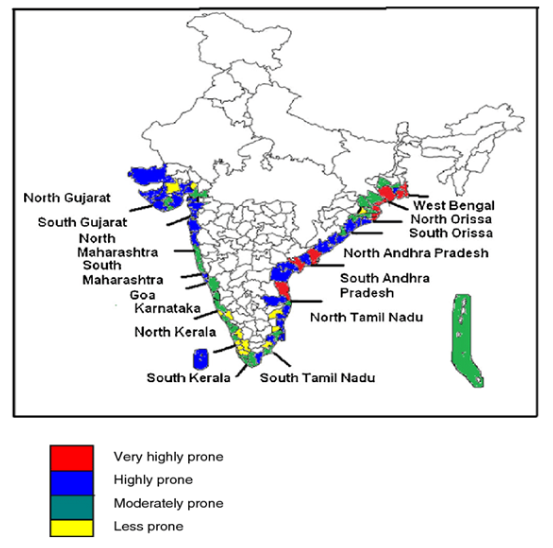
Source :
Where to use :
Paper I ( Geography Optional ) : Tropical Cyclones, Global Climate change
BIRD SPECIES IN NORTH EASTERN INDIA SHIFTING TO HIGHER ELEVATIONS
Why in news : Researchers say certain bird species shifting to degraded forest systems for climate change adaptation may go extinct .
Background : Research findings from the Indian Institute of Science (IISc) regarding the impact of deforestation and climate change on bird species in northeastern India. The study focuses on the montane broadleaved forest in the Eaglenest Wildlife Sanctuary of Arunachal Pradesh in the Eastern Himalayas.
- The findings are significant in understanding the combined effects of habitat loss and climate change on avian populations, particularly in tropical montane regions.
Overview:
- Location and Ecosystem Studied: Researchers focused on the montane broadleaved forest in the Eaglenest Wildlife Sanctuary, Arunachal Pradesh, part of the Eastern Himalayas. This ecosystem ranges from approximately 150-200 meters to 3,500 meters in elevation.
- Duration and Scope of Study: The study spanned from 2011 to 2021, capturing 6,189 individuals from 130 species. The final analysis concentrated on 4,801 understorey insectivores, encompassing about 61 species.
Key Findings:
- Impact of Deforestation: Logged (deforested) areas exhibited above-average temperatures and lower humidity compared to primary (undisturbed) forests. This led to a hastened ecological transition.
- Temperature and Humidity Differences: Primary forests were found to be 2.3 degrees Celsius cooler and 14.6% more humid than logged forests, affecting habitat suitability for various bird species.
- Species Size and Habitat Colonization: Smaller bird species adapted better to logged forests due to their higher tolerance for elevated temperatures. In contrast, larger bird species showed an increasing presence in primary forests, likely due to their higher energy requirements and reliance on abundant resources.
- Resource Availability: Primary forests had lower densities of foliage-dwelling arthropods, impacting the abundance of larger bird species.
- Bird Population Trends: In the studied sites, bird populations at the cold-edge limit exhibited increased survival rates over time, while those at the warm-edge elevational range limit showed declines, indicating adaptation to climate change by shifting ranges upslope.
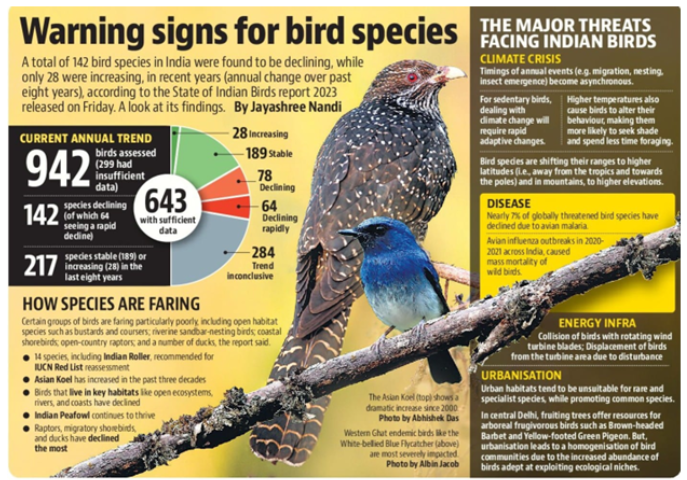
Long-Term Impacts and Recommendations:
- Sustainability of Bird Populations: Birds of the same species struggled to maintain demographic vital rates in higher-elevation logged forests, possibly due to reduced resource availability, thus impacting local biodiversity and bird demographics.
- Conservation Strategies: The study emphasizes the necessity of protecting primary forests to mitigate climate change effects on avian populations. Logging managers are urged to ensure the protection of undisturbed forests across large elevational gradients.
- Implications for Range Shifts: Protecting primary forests will facilitate species' upward range shifts in response to climate change, enhancing survival chances. In contrast, encountering degraded forests during these shifts could lead to local extinctions of certain species.
Where to use :
Paper I ( Geography Optional ) : Biogeography , Climate change , Biodiversity , Factors influencing distribution of plants and animals , Global and regional ecological changes
Electronic soil - Edukemy Current Affairs
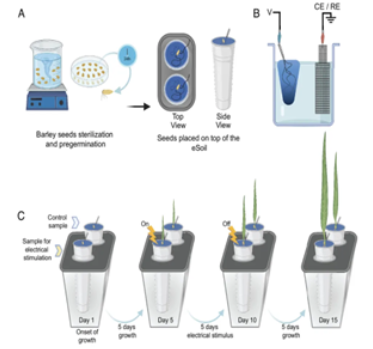
Electronic soil : The electronic soil (eSoil) developed is a novel conductive cultivation substrate tailored specifically for hydroponic systems. Unlike traditional substrates like mineral wool, which are non-biodegradable and manufactured using energy-intensive processes, eSoil is composed of cellulose, a biopolymer, blended with a conductive polymer known as PEDOT (Poly(3,4-ethylenedioxythiophene)). This innovative blend of materials allows for the stimulation of root systems in plants through low-power electrical currents.
Antarctic Circumpolar Current
Antarctic Circumpolar Current : It is a wind-driven ocean current that flows around Antarctica from west to east. It is the only current that flows around the entire globe, connecting the Atlantic, Indian, and Pacific Oceans. The ACC is also the world's largest and strongest ocean current. The ACC is very cold, with temperatures ranging from –1 to 5°C, and speeds up to 2 knots (3.7 km per hour). It extends from the sea surface to depths of 4000 m (more than 2.5 miles) and can be more than 120 miles wide.
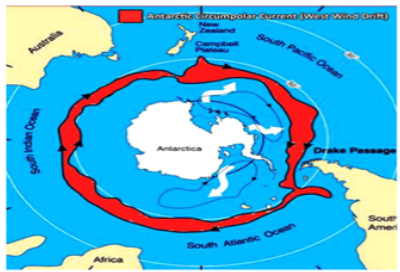
Pelagic Birds
Pelagic Birds : Pelagic birds are species that spend a significant amount of their lives on the open ocean. They are adapted to life in the marine environment, with feeding, breeding, and other behaviors deeply intertwined with the oceanic ecosystem. They have distinctive wing adaptations, with exceptionally long and thin wings that allow them to fly effortlessly for long periods without rest. Many pelagic birds also have special salt glands.
Biodiversity Credits
Biodiversity Credits : Biodiversity credits are a financial instrument that generates funding for the conservation, restoration, and sustainable use of biodiversity-rich areas. They are similar to carbon credits, but focus on biodiversity preservation rather than offsetting negative impacts. Biocredits are not designed to offset or compensate for actions with negative impacts on biodiversity. Instead, proceeds from the sale of biocredits are used to protect and restore biodiversity where it exists. To promote biocredits, the biodiversity credit alliance was also launched at CoP15.
Flue Gas Desulfurization (FGD)
Flue Gas Desulfurization (FGD): It is a set of technologies used to remove Sulphur dioxide (SO2) from exhaust flue gases of fossil-fuel power plants and from the emissions of other Sulphur dioxide-emitting processes such as waste incineration.
- FGD systems may involve wet scrubbing or dry scrubbing. In wet FGD systems, flue gases are brought in contact with an absorbent, which can be either a liquid or a slurry of solid material. The Sulphur dioxide dissolves in or reacts with the absorbent and becomes trapped in it.
- In dry FGD systems, the absorbent is dry pulverized lime or limestone; once absorption occurs, the solid particles are removed by means of baghouse filters.
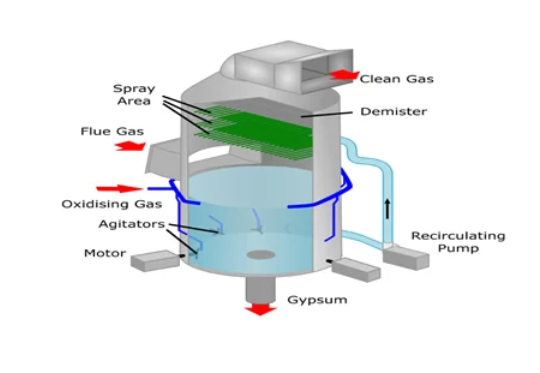
CORAL REEF RESTORATION AT MITHAPUR , GUJARAT
The Gujarat Forest Department, the Wildlife Trust of India (WTI) and Tata Chemicals Limited (TCL) pioneered a crucial project to restore coral ecosystems in the state, after beginning and continuing collaboration through whale shark conservation. Beginning with creating an inventory of the biodiversity in Mithapur reef, the project also evaluated threats, took actions to mitigate them and even worked at spreading awareness on this important ecosystem. The highlight of the project was the unprecedented attempt to transplant locally-extirpated coral species as well as to enrich reef health through restoration activities including placement of artificial substrates for the corals to extend their reach.
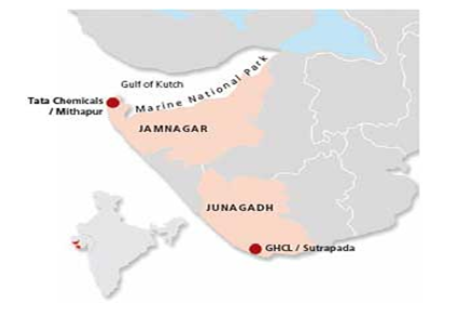
Where to use :
Paper I ( Geography Optional ) : Coral reefs and Coral Bleaching.
Paper II ( Geography Optional ) : Contemporary issues
Places in News - 10 January 2024
1. Dzükou valley
Why in news : The Dzükou lily, also known as Lilium chitrangadae, is a rare plant species that is becoming harder to find in the valley.
- It is a valley located in between Senapati district of Manipur and Kohima district of Nagaland in Northeast India.
- It is situated at an altitude of 2,452 m (8,045 ft) above sea level.
- The valley is famous for its wide range of flowers in every season but the most famous one is the "Dzükou Lily" (Lilium chitrangadae), named after the mother of its discoverer, Hijam Bikramjit
- Approx. Kohima
2. Almora fault
Why in news : Union Earth Sciences Minister reported an increased number of earthquakes in 2023, attributing it to the activation of the Almora Fault in Western Nepal.
- It is a geological fault that runs through Western Nepal and into India's Uttarakhand area.
- It is located in the Himalayan fault zone on the Main Boundary Thrust (MBT).
- In Kumaon, Uttarakhand, there are two thrusts: the South Almora Thrust and the North Almora Thrust.
- Approx. Almora
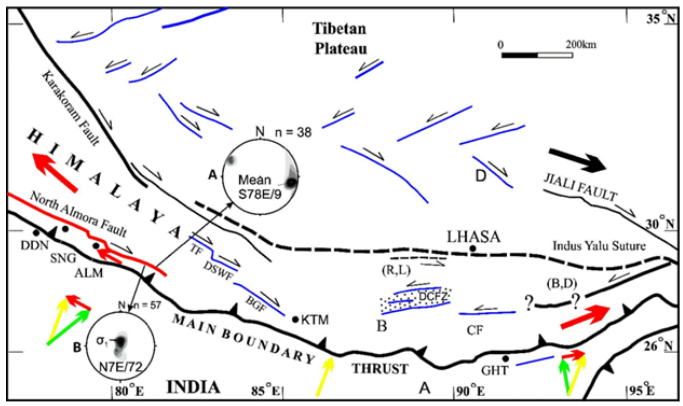
3. Jharsuguda
Why in news : Electricity arrives after 65 years in the villages of Jharsuguda.
- It is a city and district headquarters of Jharsuguda district of Odisha, India.
- It is an industrial hub, consisting mainly of metallurgical industries.
- It is well connected to major cities of India through the rail network, and a recently inaugurated Jharsuguda Airport, now renamed as Veer Surendra Sai Airport.
- It is popularly known as the "Powerhouse of Odisha" due to its Mega Steel, Aluminium & Power Projects.
- Approx : Sundergarh
4. Pong Dam
Why in news : Over 25,000 people displaced by the Pong dam on the Beas river in Himachal Pradesh have been waiting to be relocated for over five decades.
- The Pong Dam, also recognized as the Beas Dam, is an embankment dam made of earth located on the Beas River in Himachal Pradesh.
- Its primary purposes include water storage for irrigation and the generation of hydroelectric power.
- Construction commenced in 1961, concluding in 1974, making it the tallest dam of its kind in the country at that time.
- The heightened water level led to the formation of a man-made lake named Maharana Pratap Sagar, named after the prominent Mewar ruler.
- Approx : Kangra
5. Valmiki Tiger Reserve
Why in news : Recently, the National Tiger Conservation Authority (NTCA) had officially announced the increase in tiger population in Valmiki Tiger Reserve (VTR).
- It is the only tiger reserve in Bihar, which forms the easternmost extent of the Himalayan Terai forests in India.
- The VTR is located in Bihar’s West Champaran district, bordering Nepal to its north and Uttar Pradesh to its west.
- Situated in the Gangetic plains bio-geographic region, the vegetation of this Tiger Reserve is a combination of Bhabar and Terai regions.
- According to the Forest Survey of India Report 2021, 85.71% of its total area is covered by forest cover.
- Wild mammals found in the forests of Valmiki Tiger Reserve include tiger, sloth bear, leopard, wild dog, bison, wild boar etc.
- Rivers Gandak, Pandai, Manor, Harha, Masan and Bhapsa flow through various parts of the reserve.
- Approx : Champaran
Fortnightly KOSMOS MCQ Practice
Q1. Consider the following statements related to Pesticide :
- The regulation of
- pesticides falls under the purview of the Insecticides Act of 1968.
- Dicofol, Dinocap, and Methomyl have been prohibited by the Indian government.
Which of the above mentioned statements are correct ?
- 1 only
- 2 only
- Both 1 and 2
- Neither 1 nor 2
Q2. Consider the following statements about Antarctic Circumpolar Current (ACC):
- The ACC (Antarctic Circumpolar Current) serves as a crucial conduit connecting the Atlantic, Pacific, and Indian Oceans, facilitating the exchange of heat between these basins.
- The prevailing direction of the current in the vicinity of Antarctica is from west to east.
Which of the above mentioned statements are not correct ?
- 1 only
- 2 only
- Both 1 and 2
- Neither 1 nor 2
Q3. Consider the following statements :
- The innovative eSoil is a specialized conductive growing medium developed for use in hydroponic systems.
- Hydroponics is a cultivation technique where plants are grown in a solution rich in nutrients, utilizing water as the primary medium, without relying on traditional soil.
Which of the above mentioned statements are correct ?
- 1 only
- 2 only
- Both 1 and 2
- Neither 1 nor 2
Q4. Consider the following statements:
- As per the findings of the Wildlife Protection Society of India (WPSI), Madhya Pradesh has documented the highest count of tiger mortalities in India.
- In India, Karnataka boasts the second-largest tiger population.
- According to the most recent report from the International Union for the Conservation of Nature (IUCN), tigers have become extinct in Cambodia, Laos, and Vietnam.
How many of the above statements are correct?
- Only one
- Only two
- All of three
- None of the above
Q5. Consider the following statements:
- The Panama Canal serves as a connection between the Atlantic and Pacific Oceans.
- The Red Sea is bordered by the nations of Ethiopia, Egypt, Saudi Arabia, Sudan, Eritrea, and Yemen.
Which of the above mentioned statements are correct ?
- 1 only
- 2 only
- Both 1 and 2
- Neither 1 nor 2
Q6. Travel & Tourism Development Index (TTDI) is released by which of the following?
- World Bank
- World Economic Forum
- World Tourism Organization
- World Trade Organisation
Q7. With reference to the Litchi Cultivation across India, consider the following statements:
- Litchi flourishes in regions with equatorial climates.
- The state of Bihar alone contributes to almost 40% of India's total litchi production.
- India holds the top position as the world's largest producer of litchi.
How many of the above statements are correct?
- Only one
- Only two
- All three
- None
Q8. Consider the following sites:
- Hemis National Park,Ladakh
- Gangotri National Park, Uttrakhand
- Khangchendzonga National Park, Sikkim
How many of the above is/are major habitat sites for Snow Leopard?
- Only one
- Only two
- All three
- None
Q9. Consider the following statements with respect to ‘abundance of wolves in India’:
- India is home to two distinct subspecies of wolves: the grey wolf, found in the peninsular region, and the Himalayan or Tibetan wolf, located in the northern part of the country.
- The IUCN categorizes the grey wolf as vulnerable, while the Himalayan wolf holds the classification of least concern.
Which of the above mentioned statements are correct ?
- 1 only
- 2 only
- Both 1 and 2
- Neither 1 nor 2
Q10. Consider the following statement:
- After China, India stands as the world's second-largest producer of steel.
- Among the states in India known for steel production, West Bengal takes the lead, followed by Jharkhand and Chhattisgarh.
Which of the above mentioned statements are correct ?
- 1 only
- 2 only
- Both 1 and 2
- Neither 1 nor 2
Q11. With reference to Biodiversity Credit Alliance, consider the following statements:
- The Biodiversity Credit Alliance was launched at the 2023 G20 Summit presided by India.
- The primary aim of the Biodiversity Credit Alliance is to secure support and increase awareness among various stakeholders, including government bodies, non-profit organizations, and private enterprises.
Which of the above mentioned statements are correct ?
- 1 only
- 2 only
- Both 1 and 2
- Neither 1 nor 2
Q12. Consider the following statements regarding Buxa Tiger Reserve:
- The northern boundary of Buxa Tiger Reserve aligns with the international border shared with Bhutan.
- Its eastern boundary links with that of Manipur State.
- The Sinchula hill range stretches along the entire northern perimeter of Buxa National Park.
How many of the above statements are correct?
- Only one
- Only two
- All three
- None
Q13. Consider the following statements :
- The fertilizer is in the nanoparticle form of urea.
- It is recommended to apply this fertilizer once the crops have developed leaves.
- This particular urea variant has been domestically produced at the National Agricultural Cooperative Marketing Federation of India Ltd (NAFED).
How many of the above statements are correct?
- Only one
- Only two
- All three
- None
Q14. Consider the following statements:
Statement I : The Wetland City Accreditation (WCA) is a voluntary accreditation program introduced by the Ramsar Convention during the 9th Conference of the Contracting Parties (COP) in 2016.
Statement II : This initiative is designed to encourage the preservation and responsible utilization of wetlands in urban and peri-urban areas while fostering sustainable socio-economic advantages for the local communities.
Which one of the following is correct in respect of the above statements?
- Both Statement-I and Statement-II are correct, and Statement-II is the correct explanation for Statement-I.
- Both Statement-I and Statement-II are correct, and Statement-II is not the correct explanation for Statement-I.
- Statement-I is correct, but Statement-II is incorrect.
- Statement-I is incorrect, but Statement-II is correct.
Q15. Consider the following statements regarding Cheetah Reintroduction Project :
- The Cheetah Reintroduction Project in India began in 2022, aiming to revive the cheetah population declared extinct in 1952.
- The project involves the translocation of cheetahs from South Africa and Namibia to Kuno National Park in Madhya Pradesh.
Which of the above mentioned statements are correct ?
- 1 only
- 2 only
- Both 1 and 2
- Neither 1 nor 2
Share the article
Get Latest Updates on Offers, Event dates, and free Mentorship sessions.

Get in touch with our Expert Academic Counsellors 👋
FAQs
Geography Current Affairs focuses on the contemporary issues, events, and developments in the field of geography. It covers recent geographical phenomena, environmental changes, geopolitical shifts, and related news. This differs from regular geography studies which may focus more on foundational concepts, historical contexts, and theoretical frameworks.
Updates are provided regularly to ensure that subscribers stay informed about the latest developments in geography. Typically, updates are provided on a fortnightly basis, depending on the frequency of significant events and changes in the field.
Absolutely. Geography Current Affairs serves as a valuable resource not only for Geography optional but also for GS papers, especially GS Paper 1 (covering Indian Heritage and Culture, History, and Geography of the World and Society) and GS Paper 3 (covering Technology, Economic Development, Biodiversity, Environment, Security, and Disaster Management). It aids in building a holistic understanding of various topics and strengthens answer-writing skills by incorporating contemporary examples and perspectives.
Geography Current Affairs holds immense importance for UPSC preparation, particularly for aspirants opting for Geography optional. It helps candidates stay updated with the latest developments, geographical phenomena, environmental issues, and geopolitical shifts worldwide, aligning them with the dynamic nature of the subject as tested in the UPSC examinations.

